The NVIDIA Titan V Preview - Titanomachy: War of the Titans
by Ryan Smith & Nate Oh on December 20, 2017 11:30 AM ESTSynthetic Graphics Performance
Moving on, let’s take a look at the synthetic graphics performance of the Titan V. As this is the first graphics-enabled product using the GV100 GPU, this can potentially give us some insight into the yet-untapped graphics capabilities of the Volta architecture. However the usual disclaimer about earlier drivers and early hardware is very much in effect here: we don’t know for sure how consumer Volta parts will be configured, and in the meantime it’s not clear just how well the Volta drivers have been optimized for graphics.
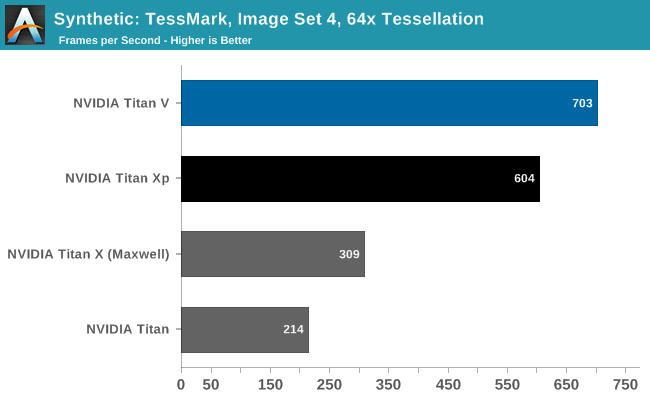
Right now the graphics aspects of the Volta architecture are something of a black box, and tessellation performance with TessMark reflects this. On Pascal, NVIDIA has one Polymorph engine per TPC; if this is the same on GV100, then Titan V has around 40% more geometry hardware than Titan Xp. On the other hand, the actual throughput rate of Polymorph engines has varied over the years as NVIDIA has dialed it up or down in line with their performance goals and the number of such hardware units available. So for all we know, Titan V’s Polymorph engines don’t pack the same punch as Titan Xp’s.
At any rate, Titan V once again comes away with a win. But the 16% lead is not a day-and-night difference, unlike what we’ve seen with compute.
Beyond3D Suite
Meanwhile for looking at texel and pixel fillrate, we have the Beyond3D Test Suite.
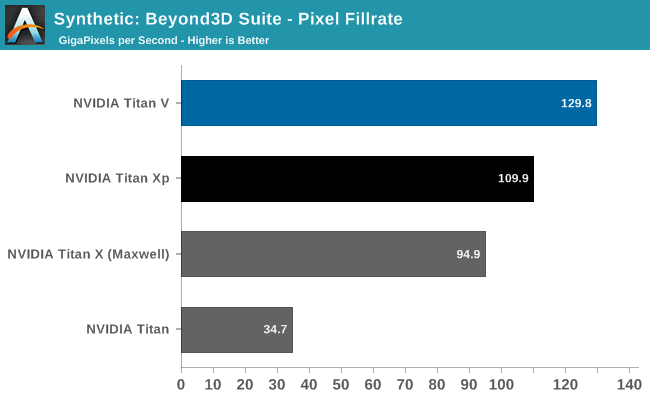
Starting with the pixel throughput benchmark, I’m actually a bit surprised the difference is as great as it is. As discussed earlier, on paper the Titan V has lower ROP throughput than the Titan Xp, owing to lower clockspeeds. And yet in this case it’s still in the lead by 18%. It’s not a massive difference, but it means the picture is more complex than naïve interpretation of GV100 being a bigger Pascal. This may be an under-the-hood efficiency improvement (such as compression), or it could just be due to Titan V’s raw bandwidth advantage. This will be worth keeping an eye on once NVIDIA starts talking about consumer Volta cards.
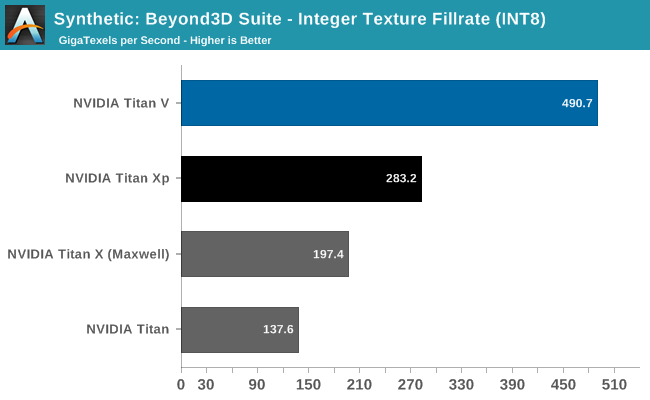
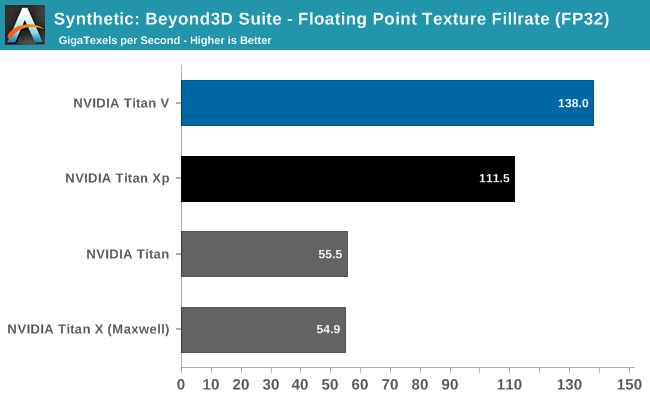
As for texel throughput, it’s interesting that INT8 and FP32 texture throughput gains are so divergent. Titan V is showing much greater INT8 texture throughput gains than it is FP32; and Titan Xp was no slouch in that department to begin with. I’m curious whether this is a product of separating the integer ALUs from the FP ALUs on Volta, or whether NVIDIA has made some significant changes to their texture mapping units.
3DMark Fire Strike Ultra
I’ve also gone ahead and run Futuremark’s 3DMark Fire Strike Ultra benchmark on the Titans. This benchmark is a bit older, but it’s a better understood (and better optimized) DX11 benchmark.
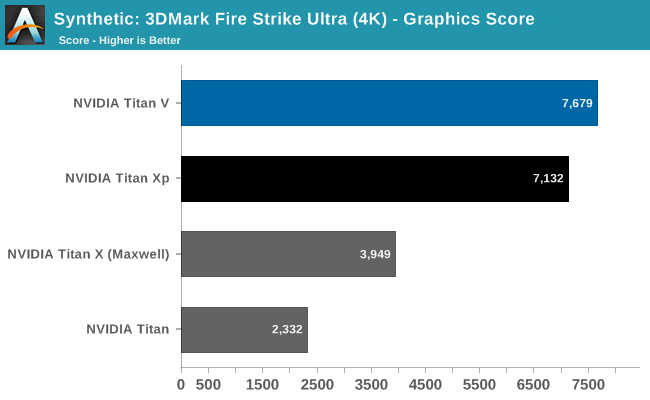
The results here find the Titan V in the lead, but not by much: just 8%. Relative to Pascal/Titan Xp, Titan V’s performance advantages and architectural improvements are inconsistent, in as much as not everything has been improved to the same degree. These results point to a bottleneck elsewhere – perhaps the ROPs? – but don’t isolate it. More significantly though, it’s an indication that while Titan V can do graphics, perhaps it’s not well-built (or at least well-optimized) for the task.
SPECViewPerf 12.1.1
Finally, while SPECViewPerf’s component software packages are more for the professional visualization side of the market – and NVIDIA doesn’t optimize the GeForce driver stack for these programs – I wanted to quickly run all of the Titans through the test all the same, just to see what we’d get.
| NVIDIA Titan Cards SPECviewperf 12.1 FPS Scores | ||||||
| Titan V | Titan Xp | GTX Titan X | GTX Titan | |||
| 3dsmax-05 | 176.3 | 173.7 | 133.1 | 100.3 | ||
| catia-04 | 180.3 | 181.4 | 71.3 | 24.1 | ||
| creo-01 | 119.4 | 122.1 | 41.0 | 30.1 | ||
| energy-01 | 27.7 | 21.2 | 8.7 | 5.8 | ||
| maya-04 | 159.0 | 152.0 | 131.6 | 98.6 | ||
| medical-01 | 89.4 | 91.9 | 39.9 | 27.7 | ||
| showcase-01 | 175.5 | 167.0 | 98.7 | 67.0 | ||
| snx-02 | 223.2 | 225.3 | 7.37 | 4.1 | ||
| sw-03 | 110.1 | 100.7 | 52.2 | 41.3 | ||
The end result is actually quite interesting. The Titan V only wins a bit more than it loses, as the card doesn’t pick up much in the way of performance versus the Titan Xp. Professional visualization tasks tend to be more ROP-bound, so this may be a consequence of that, and I wouldn’t read too much into this versus anything Quadro (or what a Quadro GV100 card could do). But it illustrates once again how Titan V has improved at some tasks by more than it has in others.










111 Comments
View All Comments
mode_13h - Wednesday, December 27, 2017 - link
It's true. All they had to do was pay some grad students to optimize HPC and deep learning software for their GPUs. They could've done that for the price of only a couple marketing persons' salaries.CiccioB - Monday, January 1, 2018 - link
That would not be a surprise.AMD strategy on SW support has always been leaving others (usually not professionist) do the job at their own cost. Results is that AMD HW has never had a decent SW support other than for gaming (and that's only because Sony and MS spend money for improving gaming performances for their consoles).
tipoo - Friday, December 22, 2017 - link
Sarcasm? There's no Vega built up to this scale.mode_13h - Wednesday, December 27, 2017 - link
It *is* pretty big and burns about as much power. Yet, it's nowhere near as fast at deep learning. Even with its lower purchase price, it's still not operationally cost-competitive with GV100.If you look at its feature set, it was really aimed at HPC and deep learning. In the face of Volta's tensor cores, it kinda fell flat, on the latter front.
Keermalec - Wednesday, December 20, 2017 - link
What about mining benchmarks?tipoo - Friday, December 22, 2017 - link
Would be in line with the CUDA improvements. I.e, two 1080s would be much better at mining. Most of the uplift is in tensor performance, which no algo uses.Cryio - Wednesday, December 20, 2017 - link
Wait wait wait.Crysis Warhead at 4K, Very High with 4 times Supersampling? I think you mean Multisampling.
I don't think this could manage 4K60 at max settings with 4xSSAA, lol.
Ryan Smith - Thursday, December 21, 2017 - link
"I think you mean Multisampling."Nope, supersampling.=)
mode_13h - Wednesday, December 27, 2017 - link
Tile rendering FTMFW.Kevin G - Wednesday, December 20, 2017 - link
"For our full review hopefully we can track down a Quadro GP100"YES. The oddity here is that the GP100 might end up being better than the Titan V at gaming due to having 128 ROPs vs. 96 ROPs and even higher memory bandwidth.
Outside of half precision matrix multiplication, the GP100 should be roughly ~43% faster due mainly to the difference in ALU counts in professional workloads. Boost clocks are a meager 25 Mhz difference. Major deviations beyond that 43% difference would be where the architectures differ. There is a chance benchmarks would come in below that 43% mark if memory bandwidth comes into play.